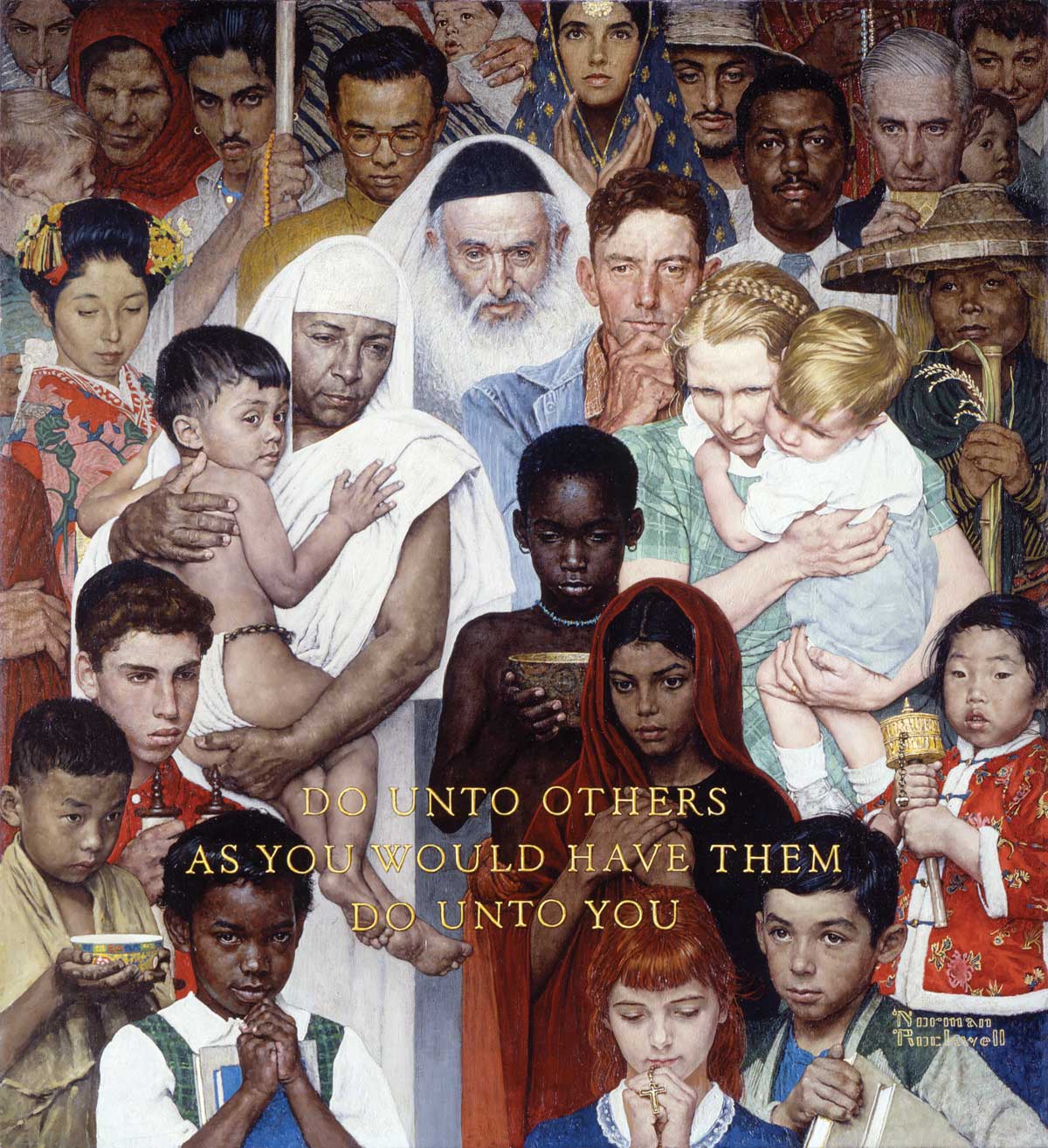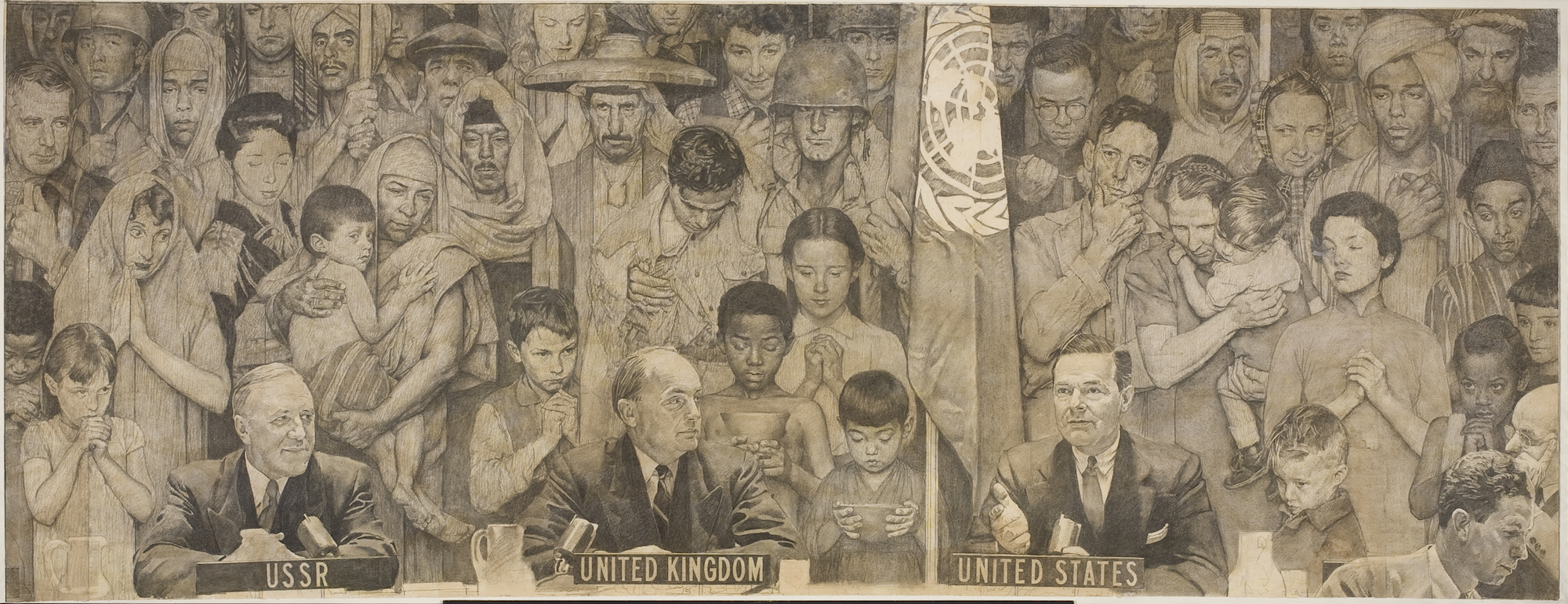The Golden Rule
Overview:
Students will look at the painting, Golden Rule, by Norman Rockwell and analyze the illustration. A class discussion will allow for students to not only talk about the composition of the painting, but also to analyze the objects and clues to decode the words at the bottom of the piece, “Do unto others as you would have them do unto you.” The students will then design an illustration of their own interpretation of the world-renowned Golden Rule.
This lesson is designed for three 50 minute class periods.
Enduring Understandings/ Essential Questions:
- “Do unto others as you would want them to do unto you” is a common thread in the many religions that guide people in the way they treat others.
- Different countries and cultures practice different religions.
- Personal reflections allow writers to think about how their lives are influenced or have changed due to new or past experiences or learnings.
- The elements of art are building blocks used to create a work of art and the principles of design describe the way artists use the elements of art within their artwork.
- The elements and principles of design contribute to the viewer’s interpretation of the visual meaning and intention of the artist.
- What does the phrase, “Do unto others as you would want done unto you,” mean?
- What would the world be like if all citizens of the world followed this principle?
- What symbols are recognized in our culture to represent peace, love and acceptance?
- How were the elements and principles of design used to make this illustration successful?
- Grade
- 9-12
- Theme
- Four Freedoms
- Length
- This lesson is designed for three- 50 minute class periods.
- Discipline
- Art
- Vocabulary
- Composition (Dynamics, triangular, Rule of Thirds, etc.); Diversity; Elements and Principles of Design; Emphasis; Mood; Religion; Symbol; Technique; Thumbnail; Sketch; United Nations; Visual Inventory
Objectives:
- Students will analyze the use of the elements and principles of design used in the illustration, Golden Rule
- Students will consider the historical and cultural events of the time that the illustration was created.
- Students will complete a worksheet, Golden Rule -Think Sheet (9-12) to prepare to create a work of visual art. Students will select and use subject matter, symbols, and ideas to communicate meaning.
- Students will create a work of visual art that demonstrates an understanding of how the communication of their ideas relates to the media, techniques, and processes they use.
- Students will participate in a group critique and then prepare and hang their illustration for display
Background:
Golden Rule, a gathering of men, women, and children of different races, religions, and ethnicities, was a precursor of the socially conscious subjects that Norman Rockwell would undertake in the 1960s. “Do Unto Others as You Would Have Them Do Unto You” was a simple but universal phrase that reflected the artist’s personal philosophy. A citizen of the world, Rockwell traveled throughout his life and was welcomed wherever he went. Of the painting Rockwell said, “I had tried to depict all the peoples of the world gathered together. That is just what I wanted to express about the Golden Rule.”
Rockwell’s Golden Rule painting later served as the inspiration for a glass mosaic that was presented to the United Nations in 1985 as a Fortieth Anniversary gift on behalf of the United States by then First Lady Nancy Reagan, made possible by the Thanks-Giving Square Foundation. Rockwell’s Golden Rule painting and his United Nations drawing were exhibited at the United Nations in honor of this humanitarian organization’s Seventieth Anniversary of the United Nations, an expression of his appreciation for humanity and democratic ideals
Materials:
Multimedia Resources:
Golden Rule
United Nations
Classroom Supplies:
- The Golden Rule As Expressed by Cultures Around the World by Sandra and Harold Darling
- Large easel with paper pad and pen, or board to record brainstorming ideas on
- Worksheet: Golden Rule - Think Sheet (9-12)
- Drawing paper and a variety of media
Activities:
Class One
- The reproduction of the Golden Rule by Norman Rockwell will be posted or projected in a central location so that all students can see the illustration.
- Ask the students if any of them have seen the image, Golden Rule, by Norman Rockwell. Ask the students to look closely at the foreground, the middle ground, and the background and to share what they see, not what they might infer. The class will collectively take a visual inventory. You may offer the first example if the students are unclear such as, “I see a lot of people standing together.” As each student contributes, restate their observation. You might be able to elaborate on what they have said to add more visual detail or you might ask them for clarification. Encourage them to look closely and carefully. By doing this, the students will analyze the work and find clues and symbols to help read the visual image, revealing American culture.
- Ask if anyone has heard of the saying, “Do unto others as you would want done unto you.” A conversation about different cultures and religions is welcomed.
Class 2
- Begin the lesson by reading a selection of pages from The Golden Rule As Expressed by Cultures Around the World by Sandra and Harold Darling and discuss the wording and meaning of a few of the sayings.
- Students will be given the worksheet, Golden Rule Think Sheet (9-12) to complete. When students have completed their plans, they should gather paper and media to begin work on their illustration.
- Circulate around the room and be available for each student if they need to talk about their ideas and material needs.
Class 3
- Allow some time for students to continue to work on their projects. About a third of the way through the period, have the students come together to present their projects and explain their design thoughts and any symbols they have used within their illustration. Once the artist has spoken, comments from classmates will be allowed. The comments must be given in a respectful manner, demonstrate critical thoughts and be relevant to the project.
- Allow for the remaining class time to be used for revisions or completion of the project. As students complete the project, have them display their illustration on a bulletin board in the school hallway.
Assessment:
- Students will be evaluated on their participation in the discussion (informal checks of understanding through questions) and completion of the worksheet: Golden Rule Think Sheet (9-12)
- Students will be evaluated on their use of relevant and sufficient evidence to support to support their interpretation of the illustration.
- Students will be evaluated on their effective use of composition as well as the elements and principles of design to communicate the intended meaning in their artwork.
- Students will participate in a group discussions and a class critique.
Standards
This curriculum meets the standards listed below. Look for more details on these standards please visit: ELA and Math Standards, Social Studies Standards, Visual Arts Standards.
- VA:Cn11.1.HSI
- Describe how knowledge of culture, traditions, and history may influence personal responses to art.
- VA:Cr1.2.HSI
- Shape an artistic investigation of an aspect of present-day life using a contemporary practice of art or design.
- VA:Cr2.1.HSI
- Engage in making a work of art or design without having a preconceived plan.
- VA:Cr2.2.HSI
- Explain how traditional and non-traditional materials may impact human health and the environment and demonstrate safe handling of materials, tools, and equipment.
- VA:Cr3.1.HSI
- Apply relevant criteria from traditional and contemporary cultural contexts to examine, reflect on, and plan revisions for works of art and design in progress.
- VA:Re8.1.HSI
- Interpret an artwork or collection of works, supported by relevant and sufficient evidence found in the work and its various contexts.

